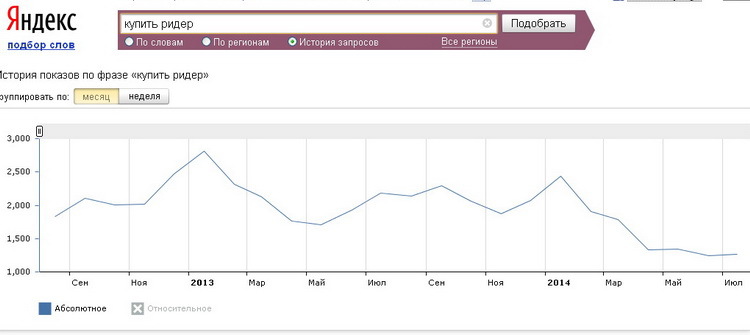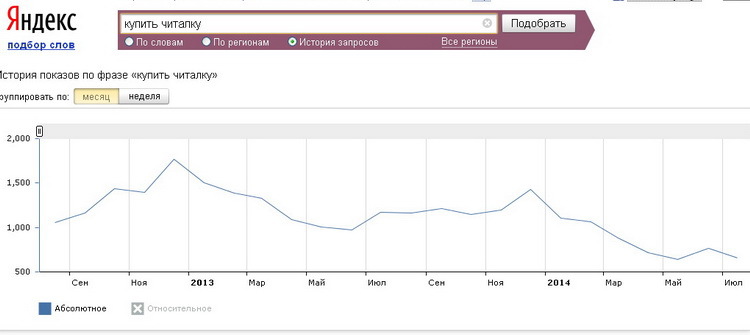E-Ink reader market in Russia: on the way to growth or oblivion?
IT journalists, in my opinion, extremely rarely make awkward headlines. Rarely - but aptly, as in the news published yesterday on Hi-Tech.Mail.Ru, "Sales of E-Ink readers are growing in Russia." In the “confirmation”, the first paragraph tells us that in 2013, these same sales in real terms fell by 25% - after growing by 54% in 2012. The first half of 2014 also did not bring optimism, minus 35%. These data are presented in the study “M.Video”, which, alas, is not freely available. And it is a pity - it would be interesting to know how the trading network explains the current growth in sales of E-Ink readers, albeit in monetary terms, by 15%. Simply put, now buyers, if they are already ready to make a choice in favor of E-Ink, then give money for expensive models.

There are data that for 2013 TFT-readers "ousted" tablets. Considering that the share of TFT-books was frankly rather big 55%, the term “ousted” here is clearly out of place. And the figures of the dynamics are not given. The author explains the observed decline in the average price of tablets. Grand numbers? No, the price tag of the “pills” dropped by only 23% before, for a moment, 9,600 rubles (~ $ 259 dollars). I doubt that this could cause unprecedented excitement, since the TFT reader from the same M.Video can be bought for 695 rubles (~ $ 18 dollars). If you fork out for a gadget for 1 590 rubles (~ $ 42 dollars) - as a gift you will receive a card for 500 rubles (~ $ 13 dollars) for the purchase of books in the corporate digital content store. The most expensive TFT reader, which at the same time received the best reviews, “robbed” for 3,490 rubles (~ $ 94 dollars). And it will be a device with an 8-inch display and Android 4.1.
')
Statistics of Yandex search queries is very eloquent, even with some fluctuations, interest in readership is steadily falling. One might think that in the request for "e-books" people can search for digital content, which means that some kind of "parasitic" growth will be revealed, but no - the graph does not change in principle.



Just here the statistics are somewhat dissonant with the actual data. For example, in the report “Liters” in Russia, the total number of sold digital publications was declared at the level of 500 million rubles (~ $ 13.5 million), an increase of 102.7% almost doubled by 2012. For 2015-2017, it is projected to take the bar at one billion rubles, that is, a two-fold jump. Unfortunately, the study did not specify on which devices people prefer to read books — readers of E Ink / TFT, tablets or smartphones.
The most popular brand in readership “offline” in the report is called PocketBook, which is beyond doubt. Perhaps, apart from the general trend of this brand, everything is in order with the interest of the audience? No, the peak of December 2013 is unlikely to ever happen again. In online sales, the most popular models are Onyx.

The global state of affairs last year quite well reflected the display manufacturer E-Ink Holdings, which in August reported a drop in profits by 46% to $ 33.6 million.

There are data that for 2013 TFT-readers "ousted" tablets. Considering that the share of TFT-books was frankly rather big 55%, the term “ousted” here is clearly out of place. And the figures of the dynamics are not given. The author explains the observed decline in the average price of tablets. Grand numbers? No, the price tag of the “pills” dropped by only 23% before, for a moment, 9,600 rubles (~ $ 259 dollars). I doubt that this could cause unprecedented excitement, since the TFT reader from the same M.Video can be bought for 695 rubles (~ $ 18 dollars). If you fork out for a gadget for 1 590 rubles (~ $ 42 dollars) - as a gift you will receive a card for 500 rubles (~ $ 13 dollars) for the purchase of books in the corporate digital content store. The most expensive TFT reader, which at the same time received the best reviews, “robbed” for 3,490 rubles (~ $ 94 dollars). And it will be a device with an 8-inch display and Android 4.1.
')
Statistics of Yandex search queries is very eloquent, even with some fluctuations, interest in readership is steadily falling. One might think that in the request for "e-books" people can search for digital content, which means that some kind of "parasitic" growth will be revealed, but no - the graph does not change in principle.



Just here the statistics are somewhat dissonant with the actual data. For example, in the report “Liters” in Russia, the total number of sold digital publications was declared at the level of 500 million rubles (~ $ 13.5 million), an increase of 102.7% almost doubled by 2012. For 2015-2017, it is projected to take the bar at one billion rubles, that is, a two-fold jump. Unfortunately, the study did not specify on which devices people prefer to read books — readers of E Ink / TFT, tablets or smartphones.
The most popular brand in readership “offline” in the report is called PocketBook, which is beyond doubt. Perhaps, apart from the general trend of this brand, everything is in order with the interest of the audience? No, the peak of December 2013 is unlikely to ever happen again. In online sales, the most popular models are Onyx.

The global state of affairs last year quite well reflected the display manufacturer E-Ink Holdings, which in August reported a drop in profits by 46% to $ 33.6 million.
Source: https://habr.com/ru/post/235883/
All Articles